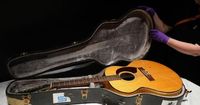London’s Olympic Park has taken on a new shine this week as the curtain lifts on a treasure trove of creativity: the David Bowie Centre at the V&A East Storehouse. Opening its doors to the public on September 13, 2025, the Centre transforms more than 90,000 relics from Bowie’s extraordinary life into a living archive, offering fans and researchers a rare chance to get up close—and sometimes even hands-on—with the belongings of one of music’s most chameleonic icons.
The sheer scale of the collection is staggering. According to the Associated Press, the archive, acquired from Bowie’s estate by the Victoria and Albert Museum, includes everything from handwritten lyrics, stage outfits, and musical instruments to personal letters, photographs, and even to-do lists scribbled on sticky notes. It’s a fitting tribute to an artist who, throughout his career, seemed to contain multitudes—constantly reinventing himself, always pushing boundaries, and never content to rest on his laurels.
Visitors to the Centre can expect to encounter artifacts that span the full arc of Bowie’s restless creativity. There’s the stringed Japanese koto, a nod to his fascination with global musical traditions, and Ziggy Stardust’s acoustic guitar, a symbol of the glam rock persona that first catapulted him to international stardom. The collection also boasts about 400 costumes, including the famed Union Jack frock coat co-designed by Alexander McQueen for Bowie’s 50th birthday concert at Madison Square Garden in 1997, and the asymmetric catsuit by Kansai Yamamoto worn during his Ziggy Stardust era.
But the archive isn’t just about the stage and spectacle. It also opens a window into Bowie’s private world. Among the more personal items are the key to the Berlin apartment he once shared with Iggy Pop in the 1970s and his Rarotonga driver’s license from his time filming the 1983 movie “Merry Christmas, Mr. Lawrence” in the South Pacific. There are fan-made gifts, such as drawings, paintings, and a handmade music box—tokens of the deep connection Bowie maintained with those who followed his career.
Perhaps most tantalizing for die-hard fans and scholars are the glimpses into projects that never saw the light of day. As reported by AP and BBC, the archive includes handwritten notes for an unfinished film titled “Young Americans”—named after his 1975 album—in which Bowie’s fictional astronaut Major Tom is sent to “a disgruntled America.” Curator Madeleine Haddon explained to Dezeen that the film would have explored what it means to be a Brit in the U.S., reflecting on international politics and the sense of dislocation that often permeated Bowie’s work. There’s also “The Spectator,” a stage musical about an 18th-century London outlaw, which Bowie was developing shortly before his death from cancer in January 2016 at the age of 69.
The David Bowie Centre itself is as thoughtfully curated as its contents. Designed by local architecture studio IDK, the space draws inspiration from Bowie’s own creative process—his penchant for experimentation, his “cut-up” lyric technique, and his magpie-like ability to blend genres and influences. The main exhibition area is divided into nine rotating displays, each highlighting a different facet of Bowie’s career: his collaborators, his influences, and the key moments that defined his artistic journey. Themed displays, reading areas, and study rooms invite visitors not only to observe but to interact, learn, and even research in depth.
“We want visitors to be inspired by Bowie, to pursue their own creativity, discover new stories and make unexpected connections between Bowie, contemporary discussions and themselves,” Haddon told AP. This ethos is evident in the Centre’s approach to accessibility. Anyone can book a free appointment to see and, in many cases, handle items under supervision. Study rooms offer one-to-one meetings with the V&A Archives team, letting visitors pore over archival objects and chart their own paths through the collection.
The response has already been enthusiastic. Since the bookings site opened this month, the most requested item is the distressed frock coat created by Bowie and McQueen—a testament to the enduring allure of Bowie’s fashion sense. “The Alexander McQueen costumes and some of the Ziggy costumes are proving particularly popular,” V&A archivist Sabrina Offord noted. For those who can’t get enough of the fashion, costumes not on mannequins are hung in sealed Tyvek bags along a clothes rail, each labeled for easy reference—a clever solution to the challenge of displaying such a vast wardrobe.
The archive’s inclusivity extends to its curation, too. According to AP, local 18- to 25-year-olds were involved in selecting which items would be displayed in the main room. Many of them, initially unfamiliar with Bowie, became convinced of his significance by the project’s end—a testament to the Centre’s mission of inspiring the next generation of artists, curators, and fans.
Of course, Bowie’s journey wasn’t always one of universal acclaim. The archive contains poignant reminders of his early struggles, such as a letter from his father, Haywood Stenton Jones, trying to secure a job for young David, and a brief rejection letter from The Beatles’ record label in 1968: “Apple Records is not interested in signing David Bowie. The reason is we don’t feel he’s what we’re looking for at the moment.” It’s a humbling counterpoint to the dazzling heights he would later reach.
Yet it is precisely this blend of triumph and vulnerability, innovation and tradition, that makes Bowie such a compelling figure. As the Centre’s rotating displays make clear, Bowie was never content to be pigeonholed. He moved seamlessly from glam rock to soul, from electronica to collaborations with British jungle and drum ‘n’ bass musicians like A Guy Called Gerald and Goldie. He acted in films and on Broadway, painted, and even set up his own internet service provider, BowieNet, in the 1990s. “He was such a world-builder,” Haddon said. “Music was (just) one angle into the worlds he wanted to build.”
The opening of the David Bowie Centre at the V&A East Storehouse is more than just a celebration of a singular artist—it’s an invitation to explore, to question, and to be inspired. For fans and newcomers alike, it’s a chance to step inside Bowie’s world and, perhaps, discover a spark of creativity to carry forward.






